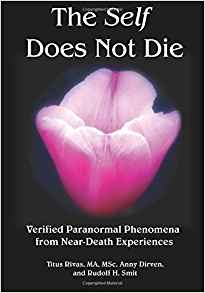Book review by Eben Alexander
THE SELF DOES NOT DIE
Titus Rivas, Annie Dirven and Rudolf H. Smit
IANDS, 2016, 366 pp.
ISBN: 978-0-9975608-0-0
True open-minded skepticism is our greatest ally in trying to better understand the mind-brain connection as it is revealed through the extraordinary lens of near-death experiences (NDEs).
True skeptics will thus greatly appreciate the rich presentation of NDEs in a new landmark book, The Self Does Not Die, originally published in the Netherlands in 2013 and recently expanded into an English edition. The authors, Titus Rivas, Anna Dirven and Rudolf H. Smit have gone to great lengths to make an objective analysis over 100 cases of veridical perception during NDEs, when the brain (according to the accepted principles of modern neuroscience) was in no condition to support such conscious experiences. The quality of empirical data and the objective assessment and refutation of possible materialist interpretations make this book a refreshing, and very worthwhile, read.
The authors begin with 14 cases of extrasensory perceptions of the patients’ immediate bodily environment. Then they progress through 18 cases of such perceptions beyond the range of the patients’ physical environment. Next they describe 36 cases of such perceptions, including the oft-discussed case of Pam Reynolds, during conditions incompatible with any conscious awareness – many of these well-documented cases occurred during cardiac arrest. Four robust cases of telepathy are examined where either the NDEer had a telepathic experience in relation to someone else, or alternatively, where someone had a telepathic awareness of the NDEer. Here they recount the extraordinary case of George Rodonaia, who was declared clinically dead for three days. After-death communications (ADCs) of NDEers with both strangers (5 cases) and with people familiar to them (6 cases) are then shared. Seven observations of NDEers having out-of-body experiences are then reported, including several in which others at a distance perceived the NDEer being out of body, and vice versa.
The authors include ten fascinating cases of healing in NDEers that are inexplicable by current medical science (so-called “miraculous healing”), including such well-known cases as Anita Moorjani and Mellen-Thomas Benedict. Finally, they cover four cases of paranormal psychic abilities, such as after-death communications (ADCs), extrasensory perception (ESP), psychokinesis (PK) and precognitive dreams after NDEs. They conclude by pointing out the materialist explanations for such phenomena are illogical and inadequate (including extensive discussion of the extreme tactics involved in trying to debunk my book Proof of Heaven).
In short, this book goes a long way towards eliminating once and for all the feeble counterclaims of the materialist position which tries to deny, ignore and generally dismiss some of these truly remarkable NDE accounts.
The Self Does Not Die is an important and timely book that offers significant empirical support to the emerging scientific view that consciousness is fundamental in the universe, and that the soul exists and does not depend on the physical brain for its conscious expression.
As one studies the scientific evidence included in this book and recent works on the mind-brain relationship (e.g. Irreducible Mind and Beyond Physicalism, etc.), it becomes clear that to reach a deeper understanding, we must reject the materialist position. These empirical data refute the production model, which states that the brain produces consciousness out of physical matter. Rather, the filter model (i.e., that the brain serves as a receiver of primordial consciousness) is far more reasonable in accounting for all the available evidence. Sooner or later, the sheer frustration with the ongoing inadequacies of materialist pseudo-explanations will nudge the prevailing western paradigm towards the deeper truth, as it is objectively represented in this remarkable book.
Buy The Self Does Not Die here.